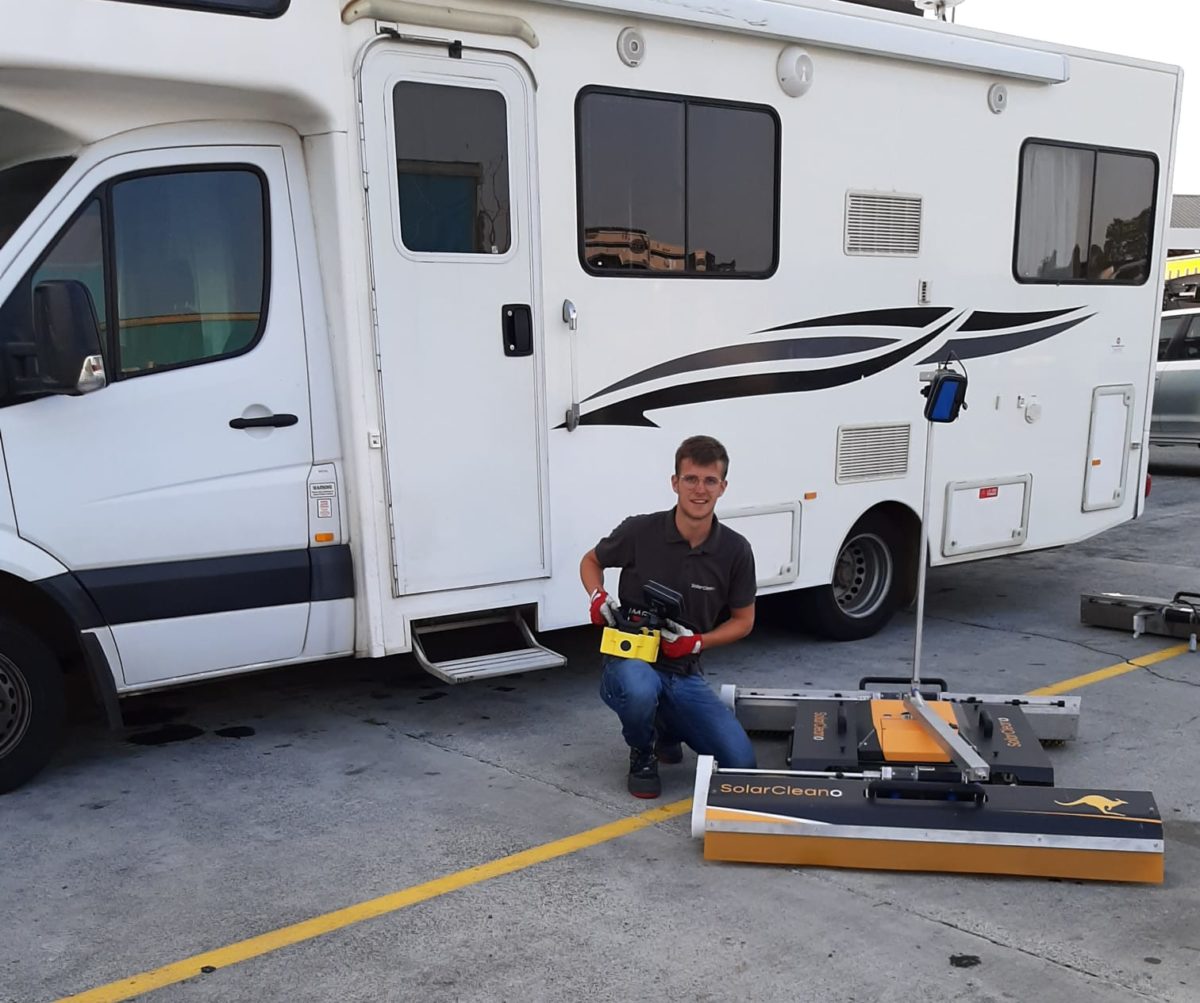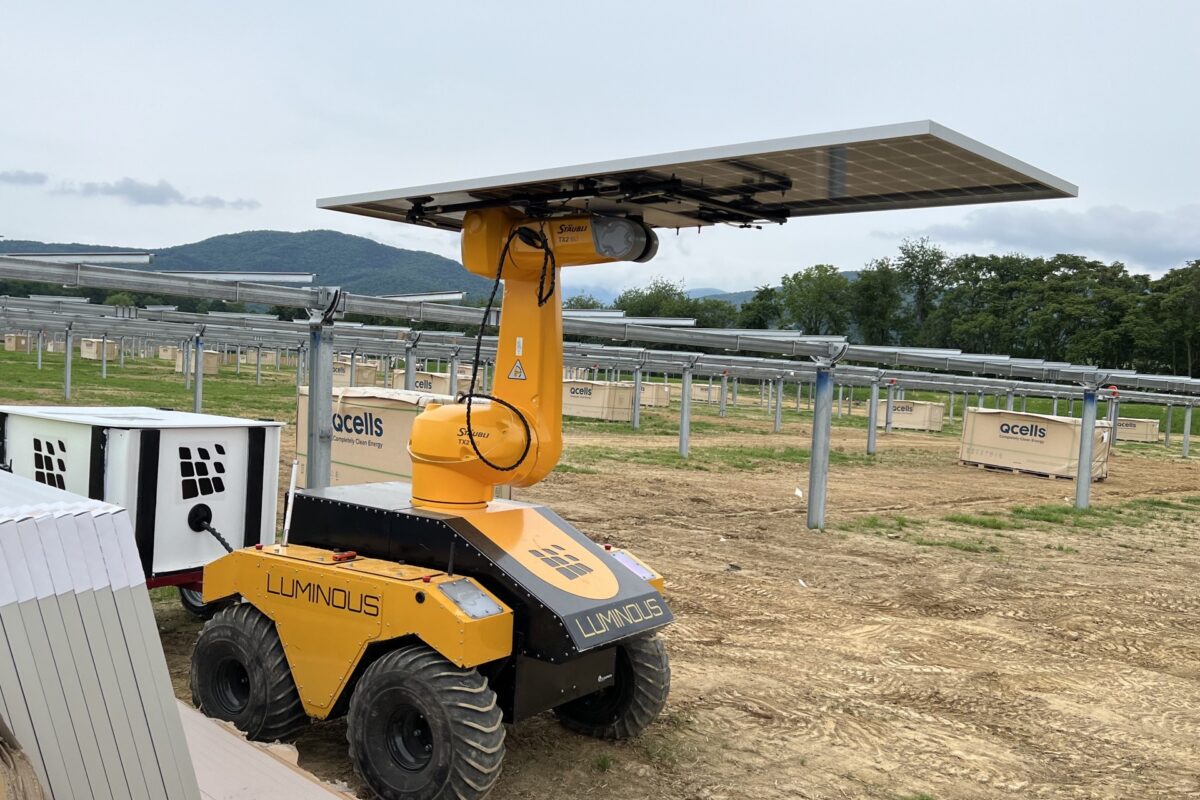In December, a young Belgian, a low-slung robot and an entourage of bristling brushes travelled in a camper van up the east coast of Australia, demonstrating the prowess of SolarCleano, as the robot is known, to solar-farm EPCs and cleaning contractors from Melbourne to Albury, Canberra to Sydney, Newcastle to Port Macquarie and on, on to Brisbane.
“In Sydney, I did a demo on a rooftop. It was a 1 MW solar installation and the cleaners told me it takes them a week to clean it. With the robot, it took three hours,” says Romain Gourmet, SolarCleano International Business Development Executive, who believes Australia is one of the last major solar markets in the world to manually clean panels.
SolarCleano is an offshoot of Fallprotec, the European designer and manufacturer of fall-arrest and height-safety systems used by window cleaners, construction workers and building-maintenance operators to ensure their security when working on rooftops and building facades.
Fallprotec partnered with a professional solar-panel cleaner to design and develop the solar-panel cleaning robot, in order to increase the efficiency and reduce the costs of solar-farm maintenance.
In the two years since SolarCleano was launched, 150 units have been deployed around the world, from Dubai, where sandstorms kick up a lot of dust and grit; to Portugal, where the heat on building rooftops triggered development of a camera-enabled remote control device that allows an operator to set SolarCleano on its way and direct it from air-conditioned comfort somewhere nearby.
Glider technology can also be deployed to anchor the robot when it is required to clean solar panels that are tilted at greater than 32 degrees (if using specially designed dry-cleaning brushes) or 25 degrees during wet cleaning.
“We develop versions of the robot based on each country’s needs or the needs of EPCs,” said Gourmet on the phone from a Gold Coast caravan park.
The dividends of dust busting
In 2017 An experimental study on [the] effect of dust on power loss in solar photovoltaic modules (authors: Athar Hussain, Ankit Batra and Rupendra Pachauri) found that in desert areas, output from dusty solar panels can be reduced by as much as 60%, and that the finer the dust particles the greater the reduction in power.
Using a robot, such as SolarCleano potentially allows more frequent cleaning of solar assets for greater output, but Gourmet says it depends on local conditions how often such maintenance should be carried out. “If your solar farm is close to the sea or near a river, you will get a lot of bird droppings and they are the worst for solar panels, so you might have to clean every two months.”
Most other large solar farms, he says, clean their panels once or twice a year.
Weight-bearing exercises
Gourmet says Australian EPCs were particularly concerned that the standard SolarCleano robot, which weighs almost 80 kilograms (a single operator can assemble its four component sections in about three minutes) might cause micro cracks in the solar panels.
“We have carried out studies with some of the biggest solar panel suppliers in the world, like Jinko and MBJ Services, to show there is no negative impact.” The robot’s weight distribution, over its 1.45-metre length and 1.3-metre width contributes to its “no-micro-cracks” certification.
Videos show SolarCleano moving fast, and Gourmet says it cleans around 2,500 square metres per hour, compared with a manual average of 400 square metres/hour.
Where solar panels are arranged in distinct rows, SolarCleano can be moved from one row of panels to another via an aluminium ramp or bridge.
https://www.youtube.com/watch?v=2voEnXXXe1M
Independent operation
To date, SolarCleano has been supplied with three batteries, each capable of powering it for three hours, but in 2020 it will be supplied with two six-hour batteries. Each battery is expected to charge 2,500 times before it needs replacing.
In dry-cleaning mode, the robotic cleaner is fully independent of power or water sources. Where wet cleaning is desirable and feasible, it can be connected to a typical garden hose and a standard tap.
Gourmet says it’s hard to estimate the overall lifetime of SolarCleano, because different component parts, such as its should be replaced after they’ve cleared 3 million square metres of dust, sand, bird droppings, moss, snow… “But the robot is designed to last at least 10 years if you maintain it,” he says.
During his tour of Australia, Gourmet met with 60 interested companies, and appointed three agents for SolarCleano, who will train operators, brief new owners on care of SolarCleano, and provide locally based sales and service for the robots.
By the end of 2020, Gourmet says the company plans to open a local assembly facility: “Our main goal is to produce our innovative product right here in Australia.”
The first SolarCleano in Australia has become a permanent resident in the care of the company’s agents, who continue the countrywide demonstration tour of its capabilities.
This content is protected by copyright and may not be reused. If you want to cooperate with us and would like to reuse some of our content, please contact: editors@pv-magazine.com.









2 comments
By submitting this form you agree to pv magazine using your data for the purposes of publishing your comment.
Your personal data will only be disclosed or otherwise transmitted to third parties for the purposes of spam filtering or if this is necessary for technical maintenance of the website. Any other transfer to third parties will not take place unless this is justified on the basis of applicable data protection regulations or if pv magazine is legally obliged to do so.
You may revoke this consent at any time with effect for the future, in which case your personal data will be deleted immediately. Otherwise, your data will be deleted if pv magazine has processed your request or the purpose of data storage is fulfilled.
Further information on data privacy can be found in our Data Protection Policy.